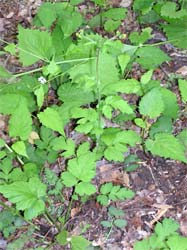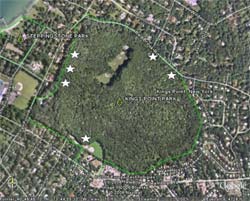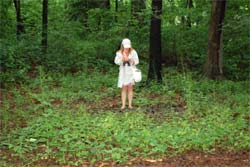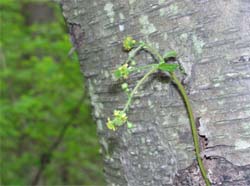Habitat Observations of Geum vernum in Kings Point Park, Long Island, and a Discussion of the Species' Potential Invasiveness in New York State
by Andrew M. Greller,¹ Virginia Dankel,² and David C. Locke³
¹ Queens College, Biology Department, Queens College, CUNY, Flushing, New York 11367
² c/o BOCES of Nassau County, 2850 North Jerusalem Road, Wantagh, New York 11554
³ Queens College, Chemistry Department, Queens College, CUNY, Flushing, New York 11367
Abstract
In this note, we report the occurrence of Geum vernum (spring avens) in Kings Point Park, Long Island, New York, and record the habitat conditions of the plant in different park locations. We also discuss the species' potential invasiveness in New York State and one possible reason for its shifting range.
Key words: climate change; disturbance; Geum vernum; invasive species; swamp forest; urban park
Introduction
On May 11, 2006, while preparing a site list of noncultivated plants in Kings Point Park, Long Island, New York, for a Long Island Botanical Society field trip, one of us (Greller) found two colonies of Geum vernum (Raf.) Torr. & Gray (spring avens). Subsequent visits to the park on May 13 and June 8 revealed four more locations for the species (Figure 1). In one of these locations, nearest to Steppingstone Park, Geum vernum was scattered along some 50 meters of trail.
Until recently, Geum vernum was considered an endangered species in New York State (NYS). Its legal status, as defined by NYS Environmental Conservation Law section 11-0535, is E—endangered species. The New York Natural Heritage Program's global and state ranking for the species, as determined by the NYS Department of Environmental Conservation and The Nature Conservancy, is G5, S1. However, Mitchell and Tucker (1997) listed Geum vernum as possibly exotic to NYS and designated it with an asterisk in parenthesis (*). And just this past year, the Natural Heritage Program moved the species from its rare-plant-status "active list" to its "watch list," and now considers G. vernum a "weedy species predicted to expand range" (Young & Weldy, 2006).
Background of the Park
Kings Point Park is a 175-acre tract of mainly wetland vegetation owned by the Village of Kings Point, in the Town of North Hempstead, Long Island, Nassau County, New York. The park dates to the 1930s, when several parcels of land were acquired and combined by the village. It was the site of a large Works Progress Administration construction project, during which "hundreds of men were brought to clear trees and install drainage pipes" (Larry Ninesling and Charles Angelo, Great Neck Parks District Office, undated mimeograph). Deep man-made ditches scar the landscape. In the 1940s, a softball field was installed at the southern end of the park on clean fill of morainal origin; baseball fields for Little League play were developed in the 1950s in the north-central section of the park. Since 1938, the park has been administered by the Great Neck Park District, by agreement with the Village of Kings Point. Most of the natural vegetation of Kings Point Park is a mosaic of swamp forests. Acer rubrum (red maple) is the dominant tree species throughout nearly the entire extent of the swamp forests. Also common, and sometimes locally dominant, are Liquidambar styraciflua (sweetgum), Nyssa sylvatica (sour gum), Sassafras albidum (sassafras), and Betula lenta (black birch). Some upland oak forests are present on the best-drained sites. Elevation in the swamps varies from 7 feet above sea level to about 15 feet above sea level. The substrate of the swamps is muck. The upland forest types are located along Red Brook Road and Kings Point Road (Figure 1) on elevations ranging from 20 feet above sea level to 47 feet above sea level. Soils of the uplands are morainal in origin but moist. The park still contains natural springs. It was designated a class I wetland on a NYS Article 24 Freshwater Wetland map, on February 20, 1987.
Description of Geum vernum Locations
All but one of the Geum vernum sites are located in swamp forests on muck soils at the edges of paths covered with wood chips. The swamp forest sites show signs of recent disturbance. Compaction of soil may be a factor in the success of G. vernum since the largest colony of the species occurs on a site that appears to be a former picnic ground (Figure 2). (An old slab of concrete—barely visible in the photograph—with the sawn-off stump of a barbecue grill pole indicates the site's past use). Soil pH may also be a factor: A pH reading taken from soil on the picnic-ground site was 5.9 (slightly acidic). This is higher than pH levels in bogs and kettle ponds in western Long Island, which can vary from 3.5 to 4.5 (Greller, unpublished data); and it is higher than moist upland sites in nearby Mill Neck (Greller, Locke, Kilanowski & Lotowycz, 1990). It is possible that the decaying concrete is contributing to the relatively high pH reading.
Near the Steamboat Lane parking lot at the southern edge of the park (see Figure 1), there is a small colony of Geum vernum adjacent to a disturbed area consisting of a pile of plant debris on top of sand and pebbles. The soil is sandier here, although mosses provide a dense groundcover.
The two types of site (swamp forest and parking lot) have the following features in common (1) an opening (since the plants occur along paths or cleared areas), (2) some recent disturbance, such as the application of wood chips or dumping of plant debris, and (3) a mixture of exotic weeds (e.g., Alliaria petiolata [garlic mustard], Duchesnea indica [Indian strawberry], Veronica hederifolia [ivyleaf speedwell], Rosa multiflora [multiflora rose], and Microstegium vimineum [Japanese stilt grass]) in the vicinity, in addition to native herbs and woody seedlings. (See Appendix 1 for a list of the plants associated with Geum vernum at its principal site.) Weeds are codominants at all G. vernum sites in the park. The populations of G. vernum here vary from between 50 to 100 plants at the picnic-ground site to as few as 5 at the Steamboat Lane site. The plants appear to be vigorous: all G. vernum sites had specimens that flowered and later set fruit (See Figure 3 and Figure 4).
Click image to enlarge

Figure 3: Geum vernum coming into flower (center). Note the pinnately dissected leaves at base of the sterile plant (lower left) and on the lower stalk of the fertile plant. Also note the leaves of Aster divaricatus (top right and left) and the fallen stem of a flowering Alliaria petiolata (diagonal at upper center of picture). (Photo by A.M. Greller; taken May 11, 2006)
Discussion
Clemants and Gracie (2006) present a northeastern range map that shows Geum vernum occurring in only three areas of NYS. One area is in New York City, another is at the southeastern end of Lake Ontario, and one is at the eastern end of Lake Erie (extending into Ontario, Canada, to range all around the lake). Otherwise, its range is to the south and west of NYS, in southeastern and southwestern Pennsylvania and then beyond that state to the southwest. In New York City, G. vernum has been found in Van Cortlandt Park, Bronx County, New York (Gerry Moore, personal communication, 2006).
Open, disturbed habitats, where competition from native species is lacking, provide niches for exotic species. Occurrences of exotic species such as Alliaria petiolata (garlic mustard) and Cardamine impatiens (narrowleaf bittercress) are becoming commonplace in the eastern U.S., even in mature forest. Southern (mountain) plants have found niches in Long Island habitats: for example, Magnolia tripetala (umbrella-tree) in mixed hardwood forest; Magnolia acuminata (cucumber-tree) in oak–red maple forest (Greller, Lindberg & Lindberg, 2000); Magnolia macrophylla (bigleaf magnolia) in a mixed oak forest in Oyster Bay (Greller and Allan Lindberg, personal observation); and Aesculus octandra (yellow buckeye) in two locations (Greller, personal observation)—one at the eastern edge of Kings Point Park, the other on a wooded shoulder of a paved road in Greenvale, Town of North Hempstead.
The arrival of many new exotics and invasives in the New York City area may be linked to record increases in temperature over the past decade. In the United States, the five most recent pentads, or 5-year periods (2000–2004, 1999–2003, 1998–2002, 1997–2001, 1996–2000), were the warmest in the last 110 years for which national records are available (Levinson, 2005). In our area, this trend is illustrated by the fact that the January 2006 average temperature recorded at New York City's Central Park meteorological station was 40.8° F, whereas the normal January average temperature there is 32.0° F (Greller, calculated from data provided by the Weather Underground website).
Conclusion
Our observations of Geum vernum in Kings Point Park suggest that the species is fairly widespread along trails and in other disturbed sites and that it occurs in relatively high pH soils with exotic plants and many native ones. As illustrated in Figure 2, the G. vernum sites we located have sparse groundcover. At the principal picnic-ground site, the soil is covered to a large extent by a thin mat of Veronica hederifolia. Above the V. hederifolia is a vegetation community of low herbs and woody seedlings, in which G. vernum, Aster divaricatus (white wood aster), and Alliaria petiolata codominate (Figure 3).
It is possible that Geum vernum is invading our area from the south, extending its natural range in eastern North America as a response to warming winters. Thus, we concur with Young and Weldy (2006) that the plant no longer should be considered endangered by NYS conservation agencies but rather that it should be watched for evidence of an explosive growth in range.



